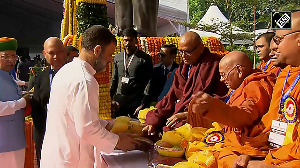If the city of Taichung succeeds in getting a Guggenheim Museum branch set up there, a goal its mayor, Jason Hu, is so valiantly fighting to achieve, it will reshape the cultural landscape not only of Taiwan and east Asia, but of the entire Asian region.
It will be Asia's first Guggenheim -- the sixth outside New York, after Bilbao, Venice, Berlin, Las Vegas and Rio de Janeiro (now under construction) -- and an international art museum on a truly gigantic scale.
It will also be the most striking piece of architecture within the Guggenheim family. Its design, by the famous Iraq-born British architect Zaha Hadid, is for a building that will, literally, move and allow the museum's various sections to dock with other spaces on demand.
That alone will be something to draw people to Taichung. When the combined muscle of Guggenheim and its content partners (the Hermitage Museum of St Petersburg and the Kunsthistoriches Museum of Vienna) is thrown in, the draw, many believe, will be irresistible.
McKinsey, the management consultancy firm that studied the feasibility of the project, feels Taichung Guggenheim is a sound commercial proposition. Taiwan already has three museums that draw over a million visitors a year, each museum considered to be the benchmark for a large-scale international art museum.
Guggenheim, says McKinsey, will provide an added reason for that market to expand. The flow of Japanese tourists to Taichung, for instance, currently around 60,000 a year, could more than double.
But to Mayor Hu, Guggenheim isn't just a museum project. He views it as the key element of an urban development master plan that he has in mind for Taichung and bets will totally refashion the city.
Taichung, 95 miles south of Taipei, is Taiwan's third-largest city and has just begun to sprout its first crop of skyscrapers. The outside world knows this city of 9,00,000 people as a leading warehousing centre, with a rapidly expanding international harbour, which will soon be connected by a north-south high-speed railway.
But Taichung is also known as a city of culture, what with its many universities and colleges, museums, public libraries, a sculpture park (the first on the island) and the famous Donghai Arts Street where art galleries, cafes, teahouses and poetry stores abound.
The new bullet train between Taipei and Kaohsiung is set to change Taichung's fortunes and bring it closer to its goal of becoming a global logistic centre. That's what Hu has in mind when he pushes his plans for the city. He wants it to be adequately ready for its new role.
He wants new streets and boulevards built and new neighbourhoods to come up in place of old. Above all, he wants the city to have a new centre of shopping, entertainment and culture, which will serve the wider international community.
That's where the proposed Guggenheim branch comes in, and Hadid's remarkable design for a structure that's supposed to move up or down or sideways like the wings of a bird.
It is to be complemented by an opera house designed by Jean Nouvel, the architect of the upcoming Guggenheim Rio, and a brand new city hall to be designed by Frank Gehry, the architect of Guggenheim Bilbao. Together, these three buildings will place Taichung, once known for its rice research, firmly in the 21st century.
Until now, however, things weren't going quite according to plan for Hu. Even though the Guggenheim is included in the government's NT$500 billion package for 10 new major infrastructure projects, there was no funding for it in this year's special budget. It was put off until next year.
An angry Hu accused the government of going back on its promise. He had hoped, as had Guggenheim president Thomas Krens, that a formal agreement for the project could be signed this year.
The government denies the accusation. In fact, last January it loaned the Taichung City government NT$286.3 million to pay the required deposit towards a Guggenheim contract and cover the initial planning costs.
Now, to pacify Hu, the Cabinet has brought its sanction forward and approved NT$5 billion to build the proposed 3,00,000 sq ft museum. The amount represents the entire 80 per cent of the government's commitment for the NT$6.25 billion project that is to be completed over the next four years. The Taichung City Council is to provide the rest.
The road is thus cleared for what will be one of Asia's important cultural landmarks, provided Guggenheim is still willing to proceed with the idea.
For Taiwan, however, Guggenheim or not, the Cabinet move heralds the start of a new cultural revolution. Under its special infrastructure plan, the government intends to spend some NT$34 billion to establish new centres of international art and music.





 © 2025
© 2025